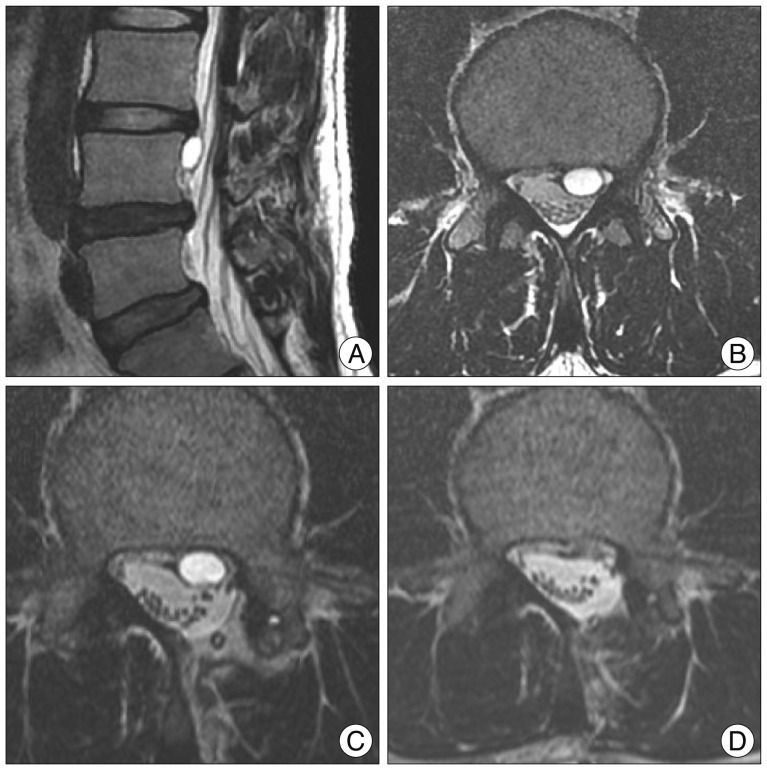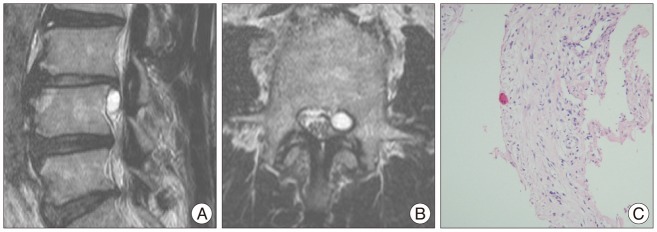1. Chiba K, Toyama Y, Matsumoto M, Maruiwa H, Watanabe M, Nishizawa T. Intraspinal cyst communicating with the intervertebral disc in the lumbar spine : discal cyst. Spine (Phila Pa 1976). 2001; 26:2112–2118. PMID:
11698889.

2. Chou D, Smith JS, Chin CT. Spontaneous regression of a discal cyst. Case report. J Neurosurg Spine. 2007; 6:81–84. PMID:
17233298.
3. Coscia MF, Broshears JR. Lumbar spine intracanalicular discal cysts : two case reports. J Spinal Disord Tech. 2002; 15:431–435. PMID:
12394670.
4. Dasenbrock HH, Kathuria S, Witham TF, Gokaslan ZL, Bydon A. Successful treatment of a symptomatic L5/S1 discal cyst by percutaneous CT-guided aspiration. Surg Neurol Int. 2010; 1:pii: 41.

5. Dommisse GF. Morphological aspects of the lumbar spine and lumbosacral region. Orthop Clin North Am. 1975; 6:163–175. PMID:
1113965.

6. Ishii K, Matsumoto M, Watanabe K, Nakamura M, Chiba K, Toyama Y. Endoscopic resection of cystic lesions in the lumbar spinal canal : a report of two cases. Minim Invasive Neurosurg. 2005; 48:240–243. PMID:
16172971.

7. Kang H, Liu WC, Lee SH, Paeng SS. Midterm results of percutaneous CT-guided aspiration of symptomatic lumbar discal cysts. AJR Am J Roentgenol. 2008; 190:W310–W314. PMID:
18430817.

8. Kikuchi S. Anatomical and experimental studies of nerve root infiltration. Nihon Seikeigeka Gakkai Zasshi. 1982; 56:605–614. PMID:
7175295.
9. Kim JS, Choi G, Jin SR, Lee SH. Removal of a discal cyst using a percutaneous endoscopic interlaminar approach : a case report. Photomed Laser Surg. 2009; 27:365–369. PMID:
19382841.

10. Kim JS, Choi G, Lee CD, Lee SH. Removal of discal cyst using percutaneous working channel endoscope via transforaminal route. Eur Spine J. 2009; 18(Suppl 2):201–205. PMID:
19034535.

11. Koga H, Yone K, Yamamoto T, Komiya S. Percutaneous CT-guided puncture and steroid injection for the treatment of lumbar discal cyst : a case report. Spine (Phila Pa 1976). 2003; 28:E212–E216. PMID:
12782997.
12. Lee HK, Lee DH, Choi CG, Kim SJ, Suh DC, Kahng SK, et al. Discal cyst of the lumbar spine : MR imaging features. Clin Imaging. 2006; 30:326–330. PMID:
16919553.
13. Loughenbury PR, Wadhwani S, Soames RW. The posterior longitudinal ligament and peridural (epidural) membrane. Clin Anat. 2006; 19:487–492. PMID:
16283649.

14. Matsumoto M, Watanabe K, Tsuji T, Ishii K, Takaishi H, Nakamura M, et al. Microendoscopic resection of lumbar discal cysts. Minim Invasive Neurosurg. 2010; 53:69–73. PMID:
20533137.

15. Murata K, Ikenaga M, Tanaka C, Kanoe H, Okuaaira S. Discal cysts of the lumbar spine : a case report. J Orthop Surg (Hong Kong). 2007; 15:376–379. PMID:
18162691.
16. Nabeta M, Yoshimoto H, Sato S, Hyakumachi T, Yanagibashi Y, Masuda T. Discal cysts of the lumbar spine. Report of five cases. J Neurosurg Spine. 2007; 6:85–89. PMID:
17233299.
17. Schellinger D, Manz HJ, Vidic B, Patronas NJ, Deveikis JP, Muraki AS, et al. Disk fragment migration. Radiology. 1990; 175:831–836. PMID:
2343133.






 PDF
PDF ePub
ePub Citation
Citation Print
Print




 XML Download
XML Download